The manufacturing industry has been faced with disruption on a massive scale. For many manufacturers, the global stress test brought on by constraints of the COVID-19 pandemic have changed operational flexibility from a desirable quality to somewhat of a necessity.
Meanwhile, consumer expectation has only grown, leaving manufacturers with the challenge of how to approach adoption of digital technologies as their competitors do the same.
The connected technology of the Industrial Internet of Things (IIoT) promises to provide manufacturers with this flexibility and now is poised to revolutionize the industrial sector, yet many manufacturers have struggled to adopt comprehensive strategies for digital transformation. If you are wondering how to surpass the pitfalls of poor implementation while discovering how IIoT can boost your business, then read on.
The Growing Market for Industrial IoT
The transition to digital tools is part of the global Industry 4.0 effort to computerize industrial processes and expand connected capabilities. Through cloud computing, IIoT systems allow for a distributed control center while creating new opportunities for automation.
According to a Markets and Markets report, the potential for growth by implementing IIoT is predicted to expand by 300% and generate $15 trillion of global GDP by 2030. This is all to say if you are not planning to expand connected capabilities, then it is likely that your competitors are.
The Challenge of Implementation
The low percentage of manufacturers who have transitioned to digital tools is likely due to the complexity of implementation. While the IoT can broadly be thought of as any device that connects to the internet, Industrial IoT denotes a network of sensors, instruments, and other interconnected devices that allow for data collection, exchange, and analysis, all of which contribute to optimization strategies. Depending on the size of a manufacturing operation, these networks can have thousands of end points, all of which generate massive amounts of data that is not always easily analyzed.
This transformation cannot be accomplished in a single upgrade, but requires consistent updates and regular evaluation of performance against long term benchmarks. The challenge of integrating connected technologies is often informed by the complexity of enabling IT/OT convergence. Older pieces of equipment that have no connectivity require supplementary devices that can effectively track and share data with the network.
Further, exiting IT and OT departments must share their respective areas of expertise to manage converged technologies and converged processes. These organizational overhauls demand respective IT and OT departments reform processes to accommodate one another and create clear line of communication that may not have previously existed.
How IIoT can Boost your Business
While implementation can initially prove challenging, there are several key improvements that IIoT offers manufacturers that are well worth the effort:
1. Cloud and Edge Computing – In order to support the connectivity IIoT demands, most efforts begin by implementing cloud solutions. Due to the scale of large manufacturing operations, successful industrial internet requires both edge and cloud solutions. Cloud storage allows IT resources to be uploaded and retrieved from the Internet as opposed to direct connection to a server, creating a distributed control center and enhanced operational visibility.
Edge-computing allows for decentralized data storage and processing closer to endpoints to ensure that operators across the industrial process see the data they need from where they need it.
2. Operational Transparency Through Data Analytics – IIoT connected sensors offer big data analytics by combining machine data from the network to generate real-time insights. This transparency provides awareness across internal operations. Recent innovations even allow performance comparison between production across sites.
Connected devices can detect supply chain disturbances allowing for the swift adaptation of production flows in real-time, reduced down time from machine failures, all with limited human intervention.
3. Optimized Performance – The synthesis of data from all supply chain entities becomes more valuable than data input from a single network because insights map inefficiencies in the production process through a holistic approach. End-to-end visibility is largely a function of being able to access data across business networks, less data siloes, and more analytics-driven insights that track quality issues.
Real-time performance updates lead to more efficient asset management both in terms of a machine’s lifecycle and reduced energy or resource usage. Additionally, aata analytics serve both to project predictive maintenance schedules while guiding improved compliance with regulatory standards.
4. Improved Supply Chain Management – Intelligence technologies have been central to improving adaptability and optimizing the supply chain for variable customer demand. Real-time visibility reveals waste by evaluating and analyzing data from all end points both within the production line and throughout the supply chain, creating more opportunities for optimization throughout the manufacturing process.
Cloud-based GPS and cost-effective Bluetooth Low Energy (BLE) asset tracking provides instantaneous updates even while cargo is in transit and real-time tracking measures transportation performance and delivery route inefficiencies. This IIoT enabled visibility allows for increased automation, eliminating logistical pain-points, leading to more accurate arrival times.
Conclusion
As the digital revolution continues, pressure mounts for manufacturers to make use of connected technologies, but the benefits of successful implementation cannot be understated. The IoT enabled manufacturer finds that production lines are accelerated even as supply chain inefficiencies are minimized. Access to decentralized control centers through cloud services allow for flexible transitions and edge intelligence where the bottom line is never out of sight. While implementation may seem daunting at first, a systematic and well planned approach can ensure that benefits of digital transformation are securely enacted.





